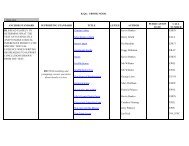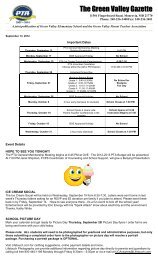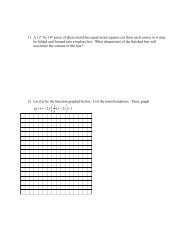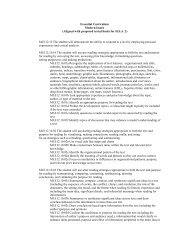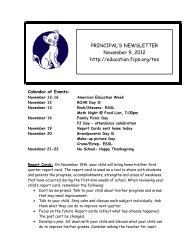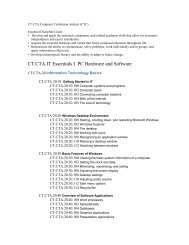Color Theory in Web Design
Color Theory in Web Design
Color Theory in Web Design
Create successful ePaper yourself
Turn your PDF publications into a flip-book with our unique Google optimized e-Paper software.
<strong>Web</strong> Development 1<br />
Name ___________________________Date ___________________Block _____<br />
<strong>Color</strong> <strong>Theory</strong> <strong>in</strong> <strong>Web</strong> <strong>Design</strong><br />
The purpose of this lesson is to provide you with a general understand<strong>in</strong>g of the role that color plays <strong>in</strong> effective<br />
web design.<br />
At the completion of this exercise:<br />
you will be able to expla<strong>in</strong> the basic concepts related to us<strong>in</strong>g color and the web.<br />
you will be able to identify and make use of color related resources onl<strong>in</strong>e<br />
you will be able to identify accessibility concerns related to color and implement key strategies to make<br />
sites accessible to people who are color bl<strong>in</strong>d<br />
Activities<br />
Read all of the resources below.<br />
Read<strong>in</strong>g Check: Respond to the follow<strong>in</strong>g questions. Have your <strong>in</strong>structor review your answers.<br />
<strong>Web</strong> Style Guide: Visual <strong>Design</strong> - http://webstyleguide.com/wsg3/7-page-design/3-visual-design.html<br />
1. What are the 3 ma<strong>in</strong> purposes of graphic design?<br />
2. What tool is helpful <strong>in</strong> design<strong>in</strong>g the layout of a page?<br />
3. What is someth<strong>in</strong>g you should always keep <strong>in</strong> m<strong>in</strong>d as you design the html and css for menu lists,<br />
content lists, page header graphics, and other design elements?<br />
4. What are the 2 most important pr<strong>in</strong>ciples of web page layout?<br />
5. Summarize the po<strong>in</strong>ts to keep <strong>in</strong> m<strong>in</strong>d for each of the follow<strong>in</strong>g design considerations:<br />
Consistency –<br />
Contrast –<br />
<strong>Color</strong> and Contrast <strong>in</strong> Typography –<br />
Contrast Variability –<br />
Avoid Overus<strong>in</strong>g Contrast –
White space –<br />
Style –<br />
Simplicity –<br />
Wikipedia: <strong>Web</strong> <strong>Color</strong>s - http://en.wikipedia.org/wiki/<strong>Web</strong>_colors<br />
6. What are the three basic colors that monitors transmit?<br />
7. How many colors could be referenced by name (e.g., "red") <strong>in</strong> HTML 4.01?<br />
8. How many different colors are there <strong>in</strong> the "web-safe" palette?<br />
9. What are the 2 reasons why this number of web-safe colors was chosen?<br />
<br />
<strong>Web</strong>AIM: <strong>Color</strong> Bl<strong>in</strong>dness - http://webaim.org/articles/visual/colorbl<strong>in</strong>d<br />
1. Are the majority of people we refer to as “color bl<strong>in</strong>d” unable to see any color at all? Expla<strong>in</strong>.<br />
2. What 2 th<strong>in</strong>gs are important to remember when design<strong>in</strong>g sites that are accessible to people who<br />
are color bl<strong>in</strong>d?<br />
<br />
<strong>Color</strong> Vision - http://www.iamcal.com/toys/colors/whatis.php<br />
1. Def<strong>in</strong>e/describe the different types of color bl<strong>in</strong>dness listed below.<br />
• Trichromat<br />
• Dichromat<br />
• Anomalous Trichromat<br />
• Monochromat
2. Click on the Statistics tab - In a class of 30 students about how many would be color bl<strong>in</strong>d?<br />
3. Experience what your webpages might look like to those with color vision deficiencies:<br />
• Click on the Palette tab.<br />
• Select NORMAL<br />
• Select CHANGE TEXT COLOR<br />
• Click on a color from the palette that you would typically consider us<strong>in</strong>g for text.<br />
• Select CHANGE BACKGROUND COLOR<br />
• Click on a color from the palette that you would typically consider us<strong>in</strong>g for a<br />
background.<br />
• Now click on each of the types of color vision deficiencies to see what your “web page”<br />
text/background color scheme would look like to those with color vision deficiencies.<br />
4. Try different color comb<strong>in</strong>ations.<br />
• Which ones would be the hardest to see by those with Deuteranomoly (the most<br />
prevalent form)<br />
5. Select a black background<br />
and green text.<br />
• What would a typical<br />
monochromat see?<br />
EXPERIENCE COLOR VISION DEFICIENCY<br />
Go to http://www.neitzvision.com/content/colorbl<strong>in</strong>dworld.html and go through the slides.<br />
1. How did you feel when asked to identify the items?<br />
2. Imag<strong>in</strong>e try<strong>in</strong>g to read a webpage that conveys <strong>in</strong>formation with color only. (as <strong>in</strong> a tra<strong>in</strong> map with route<br />
colors) How would you feel if you were try<strong>in</strong>g to follow someone’s directions that told you to take the<br />
red l<strong>in</strong>e and switch to the green l<strong>in</strong>e at a particular station, for example?






